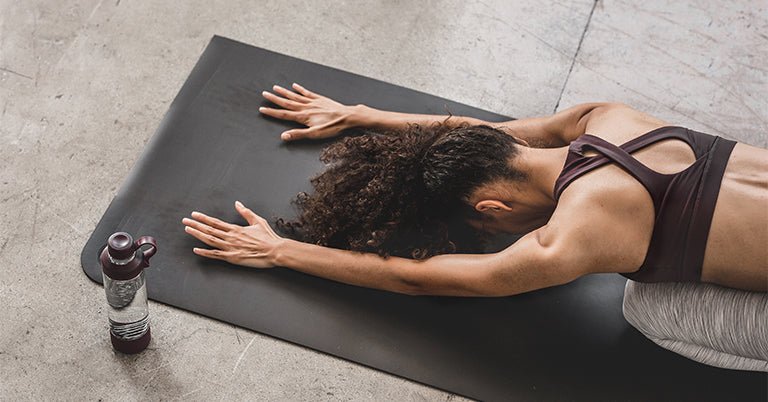Did you have a high school coach who instructed you to stretch after exercise? Does your current trainer want you to stretch beforehand? Or maybe your training buddy thinks you shouldn't stretch at all.
There are many different opinions and a great deal of conflicting research when it comes to stretching. And to confuse things even further, not all stretching is the same. Perhaps the greatest debate is between the two main types: static stretching vs. dynamic stretching.
Typically, stretching is done for one or more of the following reasons: to increase flexibility, reduce the risk of injury, improve performance, and enhance recovery. So what type of stretching should you do for which reason, and when? Let's explore the differences between static stretching and dynamic stretching and the reasons to stretch one way or another. We'll also share examples of each type of stretching, so you'll have a clear understanding of each.
Ready?
Static vs. Dynamic Stretching: What's the difference?
Static stretching is the type of stretching that most people are familiar with. During static stretching, the muscle is extended to the point of resistance and held for a period of time usually 15-60 seconds. The stretch is typically repeated three times. When you pull your foot up behind your glutes, pushing your hips slightly forward until you feel the stretch in your quadriceps muscle, and then hold for 30 seconds, that's static stretching.
Dynamic stretching is more like a warmup than a traditional stretch. As you may have guessed, the name implies movement. Dynamic stretching takes the muscles and joints through a full range of motion often similar to the sport that you are preparing to perform. Swimmers often swing their arms in circles as a way of dynamic stretching before getting in the pool.

When to Use Static vs. Dynamic Stretching
Simply put, you can look to dynamic stretching as a warmup before your workout, and static stretching as part of your cool down or recovery. But you probably want to know a bit more about the reasons why.
Dynamic Stretching Dos & Don'ts
Dynamic stretching is ideal as a warmup prior to exercise. Dynamic stretches can decrease passive stiffness and improve range of motion by taking a muscle or joint through a movement repeatedly, increasing the degree of movement slightly each time. By warming up your muscles and joints with dynamic stretching, you can prepare them for optimal activation and performance. Studies show that dynamic stretching can benefit athletes whose sports involve dynamic bursts of movement (running and jumping), such as soccer, basketball, and track. Likewise, evidence points to dynamic stretching as a plus before force and power activities like weightlifting.
With cardio exercise, it's easy enough to understand how dynamic stretching is helpful. Imagine going straight from standing still to your 10K run pace. Then imagine warming up with an easy 10-minute jog first, before hitting your race pace. Which one would feel better for your body? It may hurt just to think about running hard without a proper warmup!
The time to avoid dynamic stretching is if you are injured unless, of course, your physical therapist prescribes dynamic stretching movements as part of your rehab protocol. Otherwise, hold off on any activity (stretching or otherwise) that might worsen your injury.
Static Stretching Dos & Don'ts
During post-exercise cool down, you'll want to turn to static stretching. Static stretching can help improve blood flow, thereby aiding muscle recovery. It also helps elongate and loosen the muscles, which can relieve muscle tension caused by the strain of exercise. Psychologically, static stretching post-exercise is a great way to signal to your brain-body connection that the work is done and the cool down and recovery phase can begin.
These days, most experts recommend against static stretching in advance of a workout. Research reviews (like this review and this other review) suggest that pre-exercise static stretching can actually inhibit muscle performance, decreasing explosive power and speed.
Overall, any type of stretching does seem to help increase flexibility. But in terms of injury risk, research and opinions are mixed as to whether stretching of any kind either decreases or increases injury risk, or has no impact whatsoever. One widely recognized review states "there is not sufficient evidence to endorse or discontinue routine pre- or post-event stretching to prevent injury among competitive or recreational athletes." So far, the best advice in terms of injury prevention seems to be the age-old adage: listen to your body.
Examples of Static vs. Dynamic Stretching
Want to add stretching to your warmup and cool down routine? Here are some examples of dynamic and static stretching. You can easily find video tutorials for each type of stretch on YouTube. The names alone help illustrate the differences between dynamic stretching movements and static stretching holds.
Dynamic Stretches
-
Leg swings
-
High kicks
-
Walking lunges
-
Jump squats
-
Arm circles
-
Hip circles
-
Spinal rotations
Static Stretches
-
Hamstring stretch
-
Quadriceps stretch
-
Calf stretch
-
Shoulder stretch
-
Side bend
-
Hip flexor stretch
-
Toe touch
Again, with the inconsistencies in research and the multiple mixed opinions about the pros and cons of stretching, we can't tell you exactly the right stretching protocol to follow. But most research along with common sense points to positive gains from a workout regimen that includes dynamic warmup exercises and static cool down stretches. Above all else, our recommendation is to always listen to your body, increase any stretching and exercise goals in small and steady increments, and avoid any activity that simply does not feel right.


Leave a comment
All comments are moderated before being published.
This site is protected by hCaptcha and the hCaptcha Privacy Policy and Terms of Service apply.